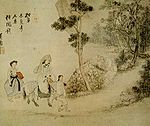Gallery
Entertainment (7)
| Picture | Title | Korean title | Description |
|---|---|---|---|
 | Dancing together with two swords | 쌍검대무(雙劍對舞) | Two kisaeng are performing geommu(sword dance) |
 | An amusing day in a spring field | 상춘야흥(賞春野興) | |
 | Resounding geomungo,praiseworthy lotus | 청금상련(廳琴賞蓮),혹은연당야유(蓮塘野遊) | |
 | A boat party on the clean river | 주유청강(舟遊淸江) | |
 | Entertainment for summering | 납량만흥(納凉漫興) | |
 | Absorbing in the ssangyuk play | 쌍육삼매(雙六三昧) | Ssangyuk is a Korean traditional game similar to chess. |
 | Playing tuho under the forest | 임하투호(林下投壺) | Tuhoo is a Korean traditional competing game similar to darts. Players draw an arrow into a vase. |
Gibang (5)
Daily life (6)
| Picture | Title | Korean title | Description |
|---|---|---|---|
 | A scenery on Dano day | 단오풍정(端午風情) | |
 | A story of a street by a stream | 계변가화(溪邊街話) | |
 | Gossiping at the well at night | 정변야화(井邊夜話) | |
 | Monks asking for alms on the street | 노상탁발(路上托鉢) | |
 | A woman washing a laundry meets the seeker | 표모봉심(漂母逢尋) | |
 | The dance of a shaman | 무녀신무(巫女神舞) |
Meeting (5)
| Picture | Title | Korean title | Description |
|---|---|---|---|
 | Young people's outgoing | 연소답청(年少踏靑) | The picture illustrates a scenery of Hanryang(man-about-town) flirting with Kisaeng on the street in spring. |
 | Leading a Kisaeng,passing on the red leaves | 휴기답풍(携妓踏楓) | |
 | Finding the temple after hearing a bell sound. | 문종심사(聞鍾尋寺) | |
 | A Buddhist nun (biguni) greeting a gisaeng | 이승영기(尼僧迎妓) | |
 | Running into each other on the street | 노중상봉(路中相逢) |
Lovers (5)
Lust (2)
| Picture | Title | Korean title | Description |
|---|---|---|---|
 | A widow's lust in spring | 이부탐춘(嫠婦耽春) | |
 | A beautiful tie between the tree in autumn | 삼추가연(三秋佳緣) |









